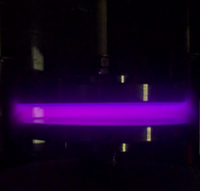Although all scientific discoveries eventually find their applications in technologies, some areas of science are driven primarily by our curiosity and our quest to understand the world we live in. However, many scientific discoveries and developments, and even entire scientific areas, are prompted directly by practical needs. The science of low-temperature plasmas and electric discharges is a good example.
Plasma Light Sources
The development of low-temperature plasma science started in the 1920s-1930s with a very practical need to develop better, more efficient light sources – fluorescent lights. The most prominent scientists, the ‘founding fathers’ of this area of science, worked in the industry: I. Langmuir at General Electric, and F.M. Penning and M.J. Druyvesteyn at Philips, and their fundamental discoveries came from work on fluorescent lights. Langmuir coined the term “plasma” in relation to ionized gases, introduced the concept of electron temperature, discovered Langmuir oscillations, invented the Langmuir probe for plasma diagnostics etc. Penning discovered the Penning ionization process during his work on trying to reduce the voltage and power required to run the fluorescent lamps. Druyvesteyn distribution function is still an important fundamental concept. These and a number of other fundamental discoveries and advances that formed the core of the science of low-temperature plasmas and electric discharges resulted from the industrial R&D.
High-Power Electric Discharge Lasers
Another big step in fundamental understanding of electric discharges and weakly ionized plasmas was directly tied to the development of powerful lasers, such as CO and CO2 electric discharge lasers, primarily for military applications, in the 1960s-1970s. In contrast to fluorescent lights where the gas is atomic and the pressure is low, electric discharge lasers operate with molecular gases at much higher pressures. Thus, new fundamental discoveries and developments were made in the studies of processes in molecular plasmas, particularly kinetics of vibrationally excited molecules and the unique role those excited molecules play. The much higher pressures and power inputs (compared with those in fluorescent lights) led to the discovery of new instabilities, followed by the work on controlling and suppressing those instabilities. New types of discharges were proposed and studied, including discharge in fast gas flow, ‘pulser-sustainer’ discharges, and non-self-sustained discharges supported by electron beams.
Microchip Fabrication
In the last four decades, the largest (by far) commercial application of weakly ionized plasmas and electric discharges was that to manufacturing of microchips, a trillion-dollar industry underpinning the technology revolution, from computers to mobile phones to AI. The microchip fabrication, including etching, vapor deposition, etc., is done with low-temperature, low pressure plasmas, and more specifically Inductively Coupled Plasmas (ICP) or Capacitively Coupled Plasmas (CCP) sustained by radio-frequency (RF) power sources. The huge practical importance of microchips gave new impetus to fundamental science of low-temperature plasmas. Fundamental findings in the physics of low-pressure RF discharges, such as the non-local behavior and the physics of sheaths, as well as new understanding of plasma-surface interactions resulted from this, essentially applied, research.
Final Thoughts
The emerging applications of weakly ionized plasmas, from plasma medicine and plasma agriculture to plasma aerodynamics and plasma-assisted combustion, have not yet resulted in fundamental scientific advances comparable in magnitude with the discoveries prompted by the development of fluorescent lights, molecular lasers, and microchip production. However, one can hope that some fundamental discoveries will be made in the near future.
